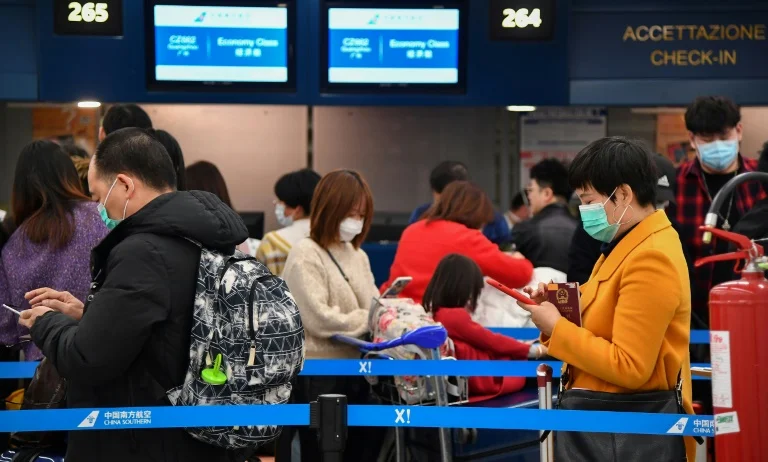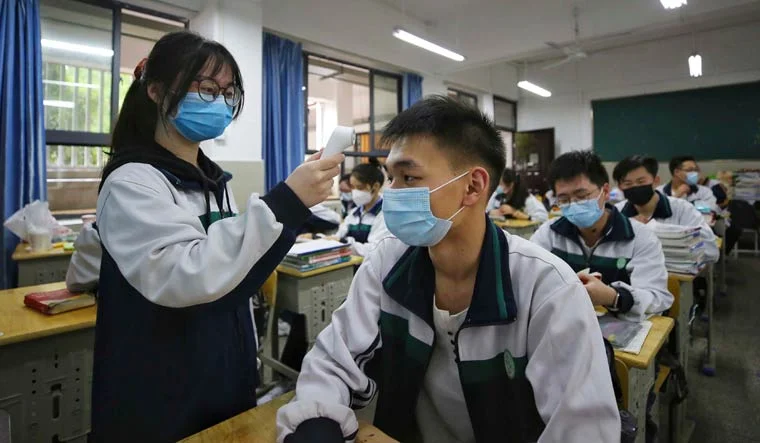
SYDNEY – As the deadly coronavirus has spread worldwide, it has carried with it xenophobia — and Asian communities around the world are finding themselves subject to suspicion and fear.
When a patient on Australia’s Gold Coast refused to shake the hand of her surgeon Rhea Liang, citing the virus that has killed hundreds, the medic’s first response was shock.
But after tweeting about the incident and receiving a flood of responses, the respected doctor learned her experience was all too common.
There has been a spike in reports of anti-Chinese rhetoric directed at people of Asian origin, regardless of whether they have ever visited the centre of the epidemic or been in contact with the virus.
Chinese tourists have reportedly been spat at in the Italian city of Venice, a family in Turin was accused of carrying the disease, and mothers in Milan have used social media to call for children to be kept away from Chinese classmates.
In Canada, a white man was filmed telling a Chinese-Canadian woman “you dropped your coronavirus” in the parking lot of a local mall.
In Malaysia, a petition to “bar Chinese people from entering our beloved country” received almost 500,000 signatures in one week.
The incidents are part of what the Australasian College for Emergency Medicine has described as “misinformation” which it says is fuelling “racial profiling” where “deeply distressing assumptions are being made about ‘Chinese’ or ‘Asian-looking’ people.”
Disease has long been accompanied by suspicions of foreigners — from Irish immigrants being targeted in the Typhoid Mary panic of 1900s America to Nepali peacekeepers being accused of bringing cholera to earthquake-struck Haiti in the last decade.
“It’s a common phenomenon,” said Rob Grenfell, director of health and biosecurity for Australia’s science and research agency CSIRO.
“With outbreaks and epidemics along human history, we’ve always tried to vilify certain subsets of the population,” he said, comparing the behaviour to 1300s plague-ridden medieval Europe, where foreigners and religious groups were often blamed.
“Sure it emerged in China,” he said of the coronavirus, “but that’s no reason to actually vilify Chinese people.”
In a commentary for the British Medical Journal, doctor Abraar Karan warned this behaviour could discourage people with symptoms from coming forward.
Claire Hooker, a health lecturer at the University of Sydney, said the responses from governments may have compounded prejudice.
The World Health Organisation has warned against “measures that unnecessarily interfere with international travel and trade”, but this has not stopped scores of countries from introducing travel bans.
The tiny Pacific nation of Micronesia has banned its citizens from visiting mainland China altogether.
“Travel bans respond largely to people’s fears,” said Hooker, and while sometimes warranted, they often “have the effect of cementing an association between Chinese people and scary viruses”.
Abbey Shi, a Shanghai-born student in Sydney, said the attitude shown by some of her peers has “become almost an attack on students who are Chinese”.
While Australia’s conservative government has banished its citizens returning from Wuhan — the central Chinese city at the epicentre of the virus — to a remote island for quarantine, thousands of students still stuck in China risk their studies being torpedoed.
“Right now it looks like they have to miss the semester’s start and potentially the whole year, because of the way the courses are set up,” Shi said.
According to Hooker, studies in Toronto on the impact of Severe Acute Respiratory Syndrome, or SARS — another global coronavirus outbreak in 2002 — showed the impact of xenophobic sentiment often lasted much longer than the public health scare.
“While there may be a cessation of direct forms of racism as news about the disease dies down, it takes quite a bit of time for economic recovery and people continue to feel unsafe,” she said.
People may not rush back to Chinese businesses or restaurants, and may even heed some of the more outlandish viral social media disinformation — such as one popular post imploring people to avoid eating noodles for their own safety.
“In one sense you might think the effects lasted from the last coronavirus to this one, because the representation as China being a place where diseases come from has been persistent,” Hooker said. (AFP)
China virus death toll rises to 425, total cases now 20,438
The death toll in mainland China from the new type of virus has risen to 425, with the total number of cases now standing at 20,438, officials said Tuesday.
The new figures come after the country opened a new hospital built in 10 days, infused cash into tumbling financial markets and further restricted people’s movement in hopes of containing the rapidly spreading virus and its escalating impact.
Japanese officials were deciding whether to quarantine more than 3,000 people on a cruise ship that carried a passenger who tested positive for the virus.
The latest figures are up from 361 deaths and 17,205 confirmed cases.
Other countries are continuing evacuations and restricting the entry of Chinese or people who have recently traveled in the country. In the province at the epicenter of the outbreak, a specialized 1,000-bed hospital started treating patients and a second hospital with 1,500 beds is to open within days.
Other countries continued evacuating citizens from hardest-hit Hubei province and restricted the entry of Chinese or people who recently traveled to the country.
The World Health Organization said the number of cases will keep growing because tests are pending on thousands of suspected cases.
Chinese President Xi Jinping, presiding over a special meeting of the country’s top Communist Party body for the second time since the crisis started, said “we have launched a people’s war of prevention of the epidemic.”
He told the Politburo standing committee that the country must race against time to curb the spread of the virus and that those who neglect their duties will be punished, state broadcaster CCTV reported.
Medical teams from the People’s Liberation Army were arriving in Wuhan, the capital of Hubei province, to relieve overwhelmed health workers and to staff the new 1,000-bed hospital, located in the countryside far from the city center.
Its prefabricated wards are equipped with state-of-the-art medical equipment and ventilation systems. A second hospital with 1,500 beds is due to open within days.
China’s Shanghai Composite stock index plunged nearly 8% on the first day of trading after the Lunar New Year holiday, despite a central bank announcement that it was putting 1.2 trillion yuan ( 173 billion) into the markets.
“We are fully confident in and capable of minimizing the epidemic’s impact on the economy,” Lian Weiliang, deputy chief of the National Development and Reform Commission, said at a news conference in Beijing.
Hong Kong’s leader, Carrie Lam, announced that the semi-autonomous territory will shut almost all but two land and sea border crossings with the mainland at midnight to stem the spread of the virus. Only the land checkpoints at Shenzhen Bay and the bridge to Macao and Zhuhai will remain open.
More than 2,000 hospital workers went on strike earlier in the day, demanding a complete closure of the border, and their union has threatened a bigger walkout Tuesday.
Hong Kong was hit hard by SARS, or severe acute respiratory syndrome, in 2002-03, an illness from the same family of viruses as the current outbreak and which many believe was intensified by official Chinese secrecy and obfuscation.
Chinese scientists said they have more evidence that it likely originated in bats.
In a study published in the journal Nature, Shi Zhen-Li and colleagues at the Wuhan Institute of Virology reported that genome sequences from seven patients were 96% identical to a bat coronavirus.
SARS is also believed to have originated in bats, although it jumped to civet cats before infecting people.
Scientists suspect the latest outbreak began at a seafood market in Wuhan where wild animals were on sale and in contact with people.
Meanwhile, Japanese health officials said a passenger on a Japanese-operated cruise ship tested positive for the virus after leaving the vessel in Hong Kong on Jan. 25.
The Diamond Princess returned to Yokohama carrying more than 3,000 passengers and crew after making port calls in Vietnam, Taiwan and Okinawa. A team of quarantine officials and medical staff boarded the ship Monday and began medical checks of everyone on board, a health ministry official said, speaking on condition of anonymity in keeping with department rules.
The passengers and crew members may be quarantined on the ship if the captain agrees to do so, the official said.
The ship’s captain said Hong Kong’s health authorities notified the ship about the passenger’s infection on Saturday, six days after he got off the ship after not being caught on thermal screening, according to a recording of the announcement tweeted by a passenger.
The patient is currently recovering and is in stable condition, and his traveling companions so far have not been infected, the captain said.
“I wish we were informed as soon as they found out, then I could have worn a mask or washed hands more carefully,” the passenger said. “I was in Hong Kong nine days ago and it seems to be too late now.”
South Korea, which has 15 confirmed cases, quarantined 800 soldiers who had recently visited China, Hong Kong or Macao or had contact with people who had, defense ministry spokeswoman Choi Hyunsoo said.
The Philippines banned the entry of all non-citizens from China after two cases were confirmed there, including the only death outside China.
The US, Japan, Singapore, Indonesia, New Zealand and Australia have imposed similar restrictions despite criticism from China and WHO’s guidance that such measures were unnecessary. (AP)
Follow this link to join our WhatsApp group: Join Now
Be Part of Quality Journalism |
Quality journalism takes a lot of time, money and hard work to produce and despite all the hardships we still do it. Our reporters and editors are working overtime in Kashmir and beyond to cover what you care about, break big stories, and expose injustices that can change lives. Today more people are reading Kashmir Observer than ever, but only a handful are paying while advertising revenues are falling fast. |
| ACT NOW |
| MONTHLY | Rs 100 | |
| YEARLY | Rs 1000 | |
| LIFETIME | Rs 10000 | |












